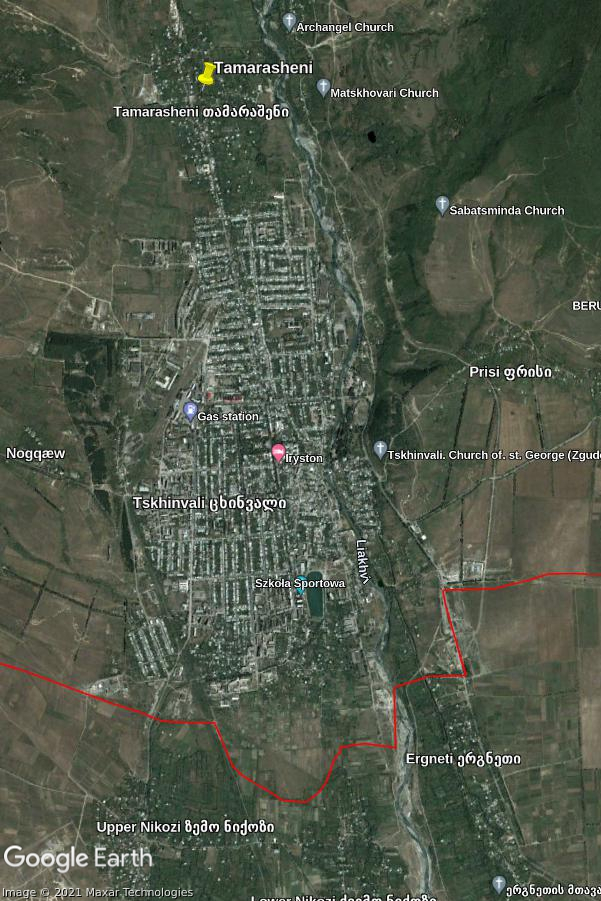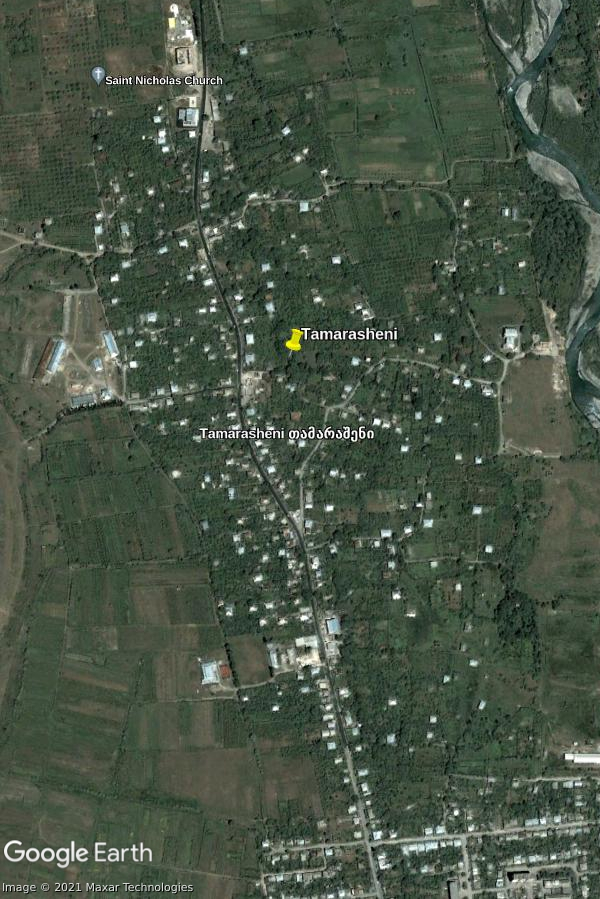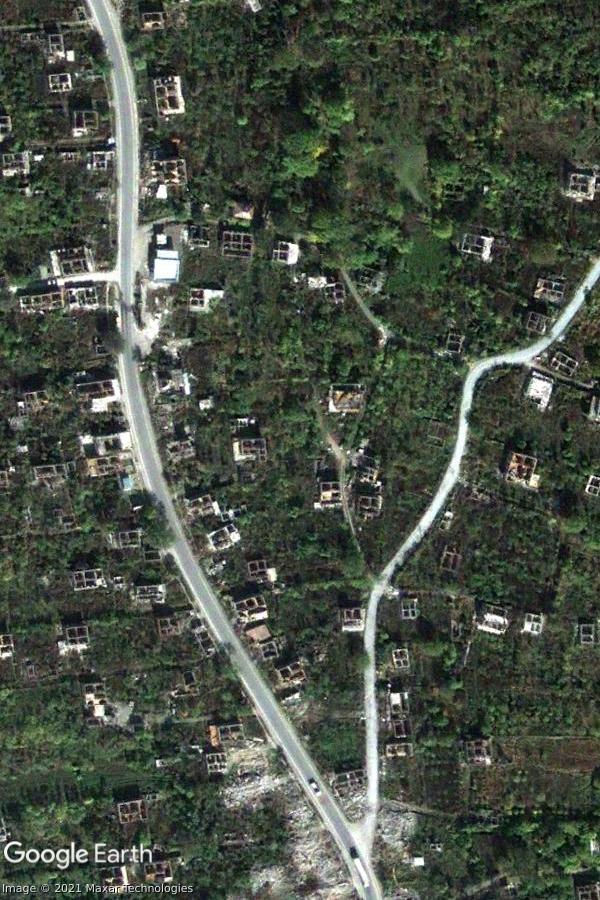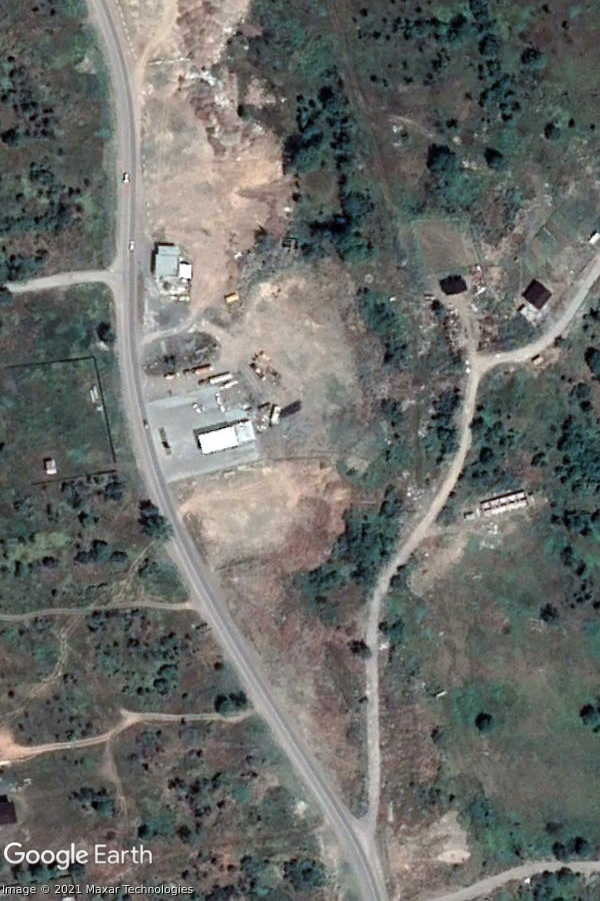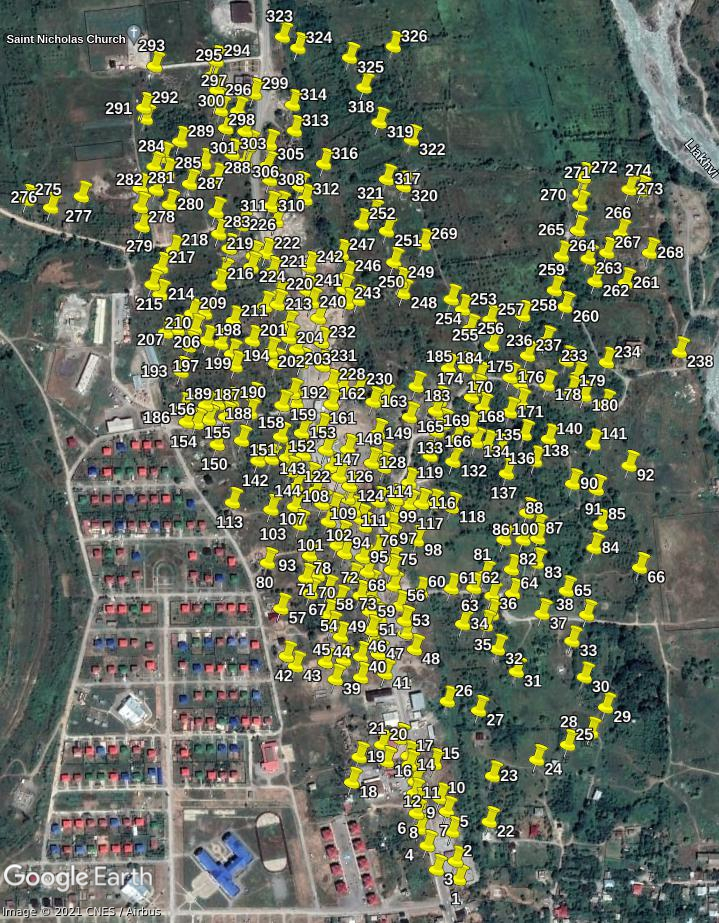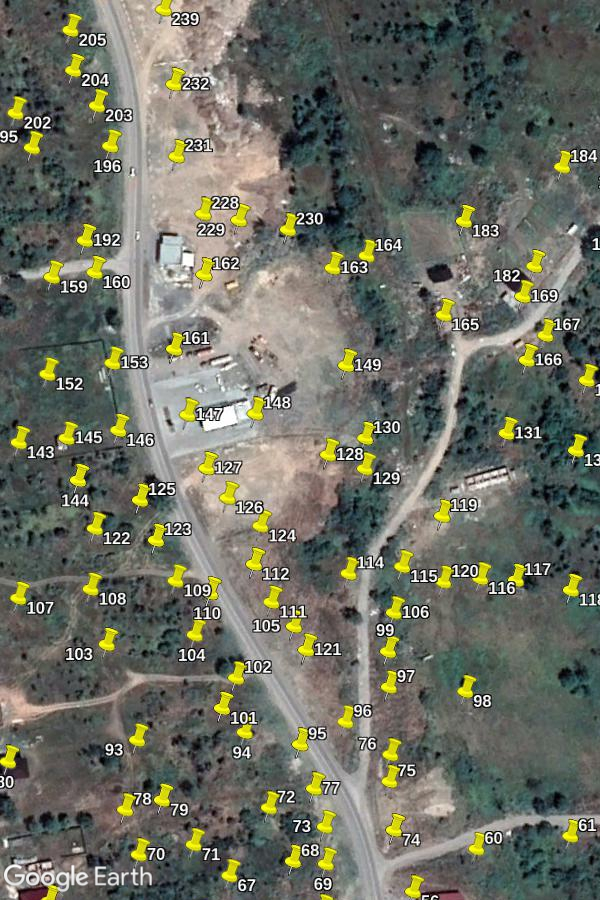RA-RA-RASPUTIN—SOUTH OSSETIA POST-BONEY M
The 15 Minutes of Fame and Subsequent Destruction of Tamarasheni
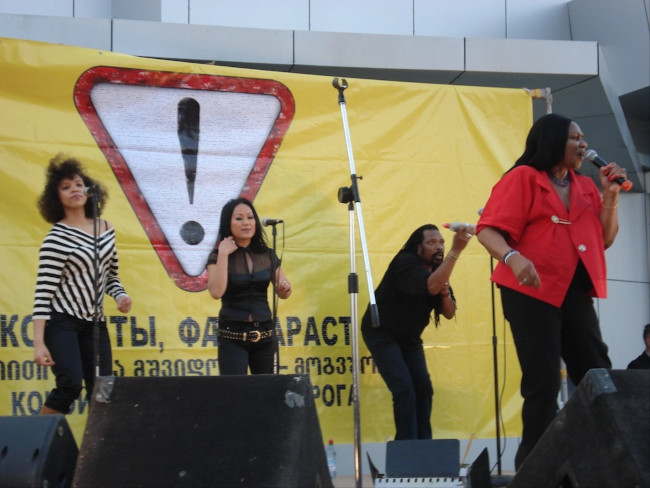
In October 2007, Mikheil Saakashvili booked Boney M to play in the tiny, ethnically Georgian and therefore loyal (to Tbilisi) village of Tamarasheni (G. თამარაშენი), just north of the South Ossetian 'capital' of Tskhinvali. This was such an extraordinary event, such a defining moment in the History of Music, such an amazing addition to the cultural diversity of the Caucasus, that the BBC even wrote an article about it at the time:
'Boney M' on Georgia's Frontline
Georgia has hired a member of 1970s pop group Boney M, famous for songs like Daddy Cool and Rasputin, in its fight for control of breakaway South Ossetia.
Marcia Barrett played a concert in a small frontline village not far from the rebel capital Tskhinvali.
Thousands of people came in cars, buses, trucks and on foot through a mountain pass skirting separatist territory to hear her sing.
The rebels have close ties with Russia and are trying to secede from Georgia.
Georgian President Mikhail Saakashvili told the BBC he hoped the music would persuade people to lay down their arms.
"We hope that we'll lure out people from their trenches, force them to drop [their] Kalashnikovs, come here and dance with the others and understand that nothing is as nice as peace, nothing is as nice as reconciliation," Mr Saakashvili said.
"This place was only famous for killings, violence, crime past and present. And now it's like adding some new thing, it's looking much more colourful, much less violent, just normal, and being normal is such a novelty here," he added.
'Peaceful life'
Ms Barrett said she did not know much about the situation in this remote region of the former Soviet Union but said she wanted to promote peace.
"Because it's a peace festival I really feel honoured to be invited to come and take part," she told the BBC.
The concert took place in Tamarasheni, a village of around 500 people that remains loyal to Georgia.
Our correspondent says the event was planned by the Georgian authorities to show the South Ossetian separatists that life would be better and more fun if they returned to government control.
In the words of a Georgian official, he says, peaceful life resumes when people sing songs.
Gun battles
The village is in the middle of the conflict and witnesses regular gun battles despite a ceasefire.
All around the area are checkpoints manned by Georgian and Ossetian forces as well as Russian peacekeeping troops.
The war that erupted when South Ossetia broke away from Georgia after the 1991 collapse of the Soviet Union cost thousands of lives.
Although the concert was billed as a Boney M gig and Marcia Barrett's band was introduced as Boney M, two groups also featuring former members of Boney M are touring under the same name.
Former Boney M vocalist Liz Mitchell had nothing to do with the concert in South Ossetia.
The legal rights to the name Boney M continue to be a matter of controversy.
Boney M have a loyal following in the former USSR. Their songs were among the few approved under Communist rule.
Saturday, 13 October 2007—http://news.bbc.co.uk/1/hi/entertainment/7042807.stm
The amazing Paul Rimple also wrote one of his inimitable articles on the concert for Eurasianet:
Georgia: Disco Music Used as Vehicle for Peace
An October 13 disco concert by a band headed by a former member of the 1970s pop sensation Boney M has become the latest strategy in Tbilisi’s efforts to woo breakaway South Ossetia back into its fold.
With an armed soldier standing overhead and Georgian President Mikheil Saakashvili grooving to the beat with fans below, Marcia Barrett, an original member of Boney M, performed hits ranging from "Daddy Cool" to "Rasputin" in front of an audience of hundreds in Tamarasheni, a Georgian-controlled village a few kilometers from the capital of breakaway South Ossetia.
Organized by the anti-separatist movement Kokoity Fandarast (Kokoity Farewell), Boney M, long a favorite band in the former Soviet Union, was chosen by Fandarast leader Vladimir Sanakoyev to be a "peace emissary" to the people of South Ossetia. The Georgian government picked up the undisclosed cost for the performance. "This is [a] disco approach to conflict resolution," President Saakashvili told a BBC reporter under the din of the all-time favorite, "Sunny."
Vladimir Sanakoyev elaborated on that theme: "In a conflict zone, people want to hear music, sing songs and dance. [Music] is a peace process method which promotes stabilization," he commented. "Boney M’s music – not just the words, but the beat and rhythm - have a Caucasus temperament," he added.
Whether the South Ossetia conflict zone had actually been serenaded by the "official" Boney M is disputable, however. The rights to the name are being contested in court by former group members.
The detail, however, was meaningless to fans who drove in caravans or hiked over a rough mountain bypass road, lined with armed soldiers, to attend the free concert. An occasionally gyrating Tbilisi Mayor Gigi Ugulava and a ramrod-straight Dmitri Sanakoyev, head of the Georgian-controlled South Ossetian district, were also on hand.
The original Boney M visited the Soviet Union in 1978; memories, apparently, still linger on. "Boney M in Tamarasheni," commented Malkhas, a man in his 30s from the nearby Georgian town of Gori. "I don’t believe it."
The concert falls on the heels of an economic development campaign, which kicked off last winter as a strategy to persuade residents in Ossetian-controlled territory to accept a Tbilisi-backed peace deal. [For background see the Eurasia Insight archive]. So far, Tamarasheni, just a few kilometers from breakaway South Ossetia’s capital of Tskhinvali, has a newly paved main road, modern electronics superstore, cinema/entertainment complex, and soccer field, in addition to a hotel, gas station and swimming pool under construction. Live music is the latest addition to the campaign.
Kokoity Fandarast has also enlisted Georgian singers and musicians to boost the popularity of their drive to oust the separatist de facto president, Eduard Kokoity. An October 3 concert in Kakheti, a region in eastern Georgia, initiated the campaign, with performances moving steadily closer to Tskhinvali. The Saturday concert featuring the de facto Boney M group marked the finale.
Tamriko Khizanishvili, de facto culture minister of Georgian-controlled South Ossetia, states that more concerts are planned for the future, putting the relatively modest turnout for the Tamarasheni gig down to difficulties traveling over the gravel mountain pass that skirts Ossetian-controlled territory.
Group members, however, seemed unconcerned that they were playing in a village still occasionally hit by sniper fire despite a long-standing cease-fire agreement. "I fought cancer twice and won. I’m never scared," Barrett responded at an earlier press conference.
Back-up singer Marcus James avows he doesn’t think of danger in South Ossetia because the concept is negative. "The main thing is to have fun and forget about the negative. Our best weapon is peace," he affirmed.
https://eurasianet.org/georgia-disco-music-used-as-vehicle-for-peace-0
This must have been a pretty legendary concert—comparable perhaps to a full Ring Cycle in the Hala'ib Triangle or to an early Wu-Tang demo cassette recorded in Birobijan—but one of the most interesting and terrifying aspects of this event is the fact that Tamarasheni itself has since been burnt to the ground and quite literally wiped from the face of the Earth... It all began in the immediate aftermath of the 2008 war, as this footage shows:
Tamarasheni's progressive transition from village to ruins and to wilderness can best be shown on Google Earth. To begin with, here are two overall views of the village and its c. 300 houses, just north of Tskhinvali, in July 2007—the most recent pre-war image GE has of the place:
|
|
|
|---|
Now compare the following two images. On the left is our usual July 2007 shot; and on the right, an image taken in October 2009, the closest we can get to the war:
|
|
|
|---|
And if we combine these two (May 2016 and finally July 2019—the most recent image available) to the previous pair, we can see all the stages—viz. from house to roofless ruin to rubble and to barren patch:
|
|
|
|---|
To give us a better idea of the scale and methodical nature of this destruction, I spent a happy hour adding some helpful pins marking the precise spot where someone's house (or shop &c.) used to stand. Here are two views—a vue d'ensemble and our usual close-up:
|
|
|
|---|
And speaking of scale: Tamarasheni was by no means the sole village to be eliminated in this manner. Its fate was shared by the villages of Kheiti, Lower and Upper Achabeti, Kurta, Dzartsemi, Kekhvi, Kemerti and Sveri to the north; Argvisi, Berula, Eredvi, Ksuisi, Disevi and Upper Kere to the east; Vanati, Jojiani, Satskheneti, Khoshuri, Beloti and Lower Zonkari to the north-east; and by Avnevi to the south-west—22 villages in all, great and small, by my count, representing literally thousands of homes. The rubble that remained was presumably used for various Russian construction projects, viz. the dozen military bases and two main roads they have subsequently built in South Ossetia.
Unless stated otherwise or obviously not the case, all the text and images on this website are © A.J.T. Bainbridge 2006-2021
Do get in touch! Gmail: alexjtb

